The best-selling cars of the 1960s - UK
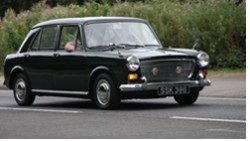
The two best-selling cars of the 1960s were the Ford Cortina and the Austin/Morris 1100. The Mini came third.
I don't have comparable statistics for the whole decade, but the top ten best-selling cars from 1965 to 1969 were as follows:
1. BMC 1100/1300
The Austin/Morris 1100 and 1300 range, which BMC launched in 1962, was a British success story.
BMC's star designer Alec Issigonis designed the 1100. Issigonis's previous success stories were the Morris Minor and the Mini. The 1100 was a grown-up Mini. It was front-wheel drive with a similar transverse engine layout as the Mini (see below). It was just over twelve feet long, but had a cabin as spacious as larger cars. BMC's management asked the Italian styling house Pininfarina to do the final styling work. The result was a crisp, good-looking car. It was understated, but modern looking.
BMC also introduced Austin, Wolseley, Riley and MG versions of the 1100. The Wolseley had a better interior with walnut facia and leather seats. The MG and Riley versions also had better trim and also better performance. There was a luxuriously appointed Vanden Plas Princess 1100 which topped the range.
In autumn 1967, BMC facelifted the 1100 range and introduced the 1300.
Although this car was a huge success for BMC they did not develop it to keep it ahead of the competition. Ford's policy was different.
2. Ford Cortina
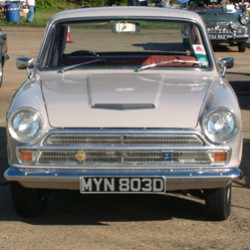
Also launched in 1962, the Ford Cortina targeted the same market, the budget family saloon. The Cortina 4-door De Luxe cost £687 at launch, the Morris 1100 4-door De Luxe cost £695. (In today's money the costs would have been £10,300 and £10,500 - yes that's right, cars were much cheaper in the 1960s.)
The Cortina was different in character to the 1100. It was a conventional, rear-wheel drive saloon. Its revolutionary feature was the price. Never before had a full-sized family saloon been so affordable.
The Ford formula was for a stylish exterior, but conventional engineering. It worked very well.
The Cortina Mk1 was used by Hattie Jacques's "Glam Cabs" in the film "Carry On Cabby" as sleek modern transport, driven by glamorous lady cabbies, to compete against husband Sid James's fleet of Austin Taxis built to a pre-war design.
What happened next was down to Ford planners' correct reading of the market. As people became more affluent they wanted to trade up to bigger and better cars. Ford made the next version of the Cortina bigger and better.
Ford launched the Cortina Mk2 in October 1966. It started with an engine size of 1300cc, with a 1500cc option. The new car was also wider and roomier.
Ford's choice was the right one and ultimately the Cortina won the sales war. It beat the BMC 1100/1300 in 1967 and became the best-selling car of the 1970s in the UK.
3. Mini
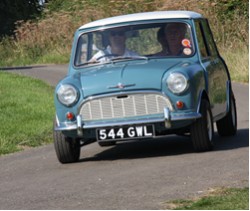
The Mini was the third best-selling car of the 1960s in the UK. The first new Minis arrived in 1959.
BMC Chairman, Leonard Lord was disgusted by the appearance of bubble cars on British roads as a result of petrol rationing following the Suez Crisis in 1957. He asked Alec Issigonis to design a car that was smaller than the Morris Minor, but could seat four people in comfort.
Issigonis's design was revolutionary. Instead of mounting the engine North-South (front-back) and driving the rear wheels, the Mini's engine was to be mounted across the car - East-West. The Mini was front-wheel drive. This arrangement meant that the new car would be at least as spacious as conventional small cars of a larger size - such as the Austin A35 or Ford Anglia.
BMC sold the Mini as an Austin Seven (or Se7en in Austin's advertising copy) or a Morris Mini Minor. Neither of these names caught on and the car became known as the "Mini". The first Minis were basic. They had sliding windows. Rubber mats covered the floor of the basic model, but the De Luxe had carpets. There was no dashboard as such, just a centrally mounted speedometer and two parcel shelves either side. There was also no heater on the basic version.
After people got used to the look of the Mini sales took off.
4. Vauxhall Viva
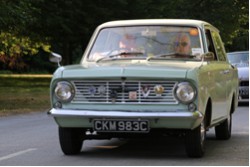
Vauxhall had specialised in large cars in the 1950s, but steadily moved into other markets. They launched the medium-sized Victor in 1957 and a new small car, the HA Viva, in 1963. The Viva was a basic small car at the budget end of the market. It was bigger than a Mini and competed with the Ford Anglia and Morris Minor.
The original concept was for a basic entry level car for customers making a step up from a motorbike and sidecar. The car was roomy enough for four and had a large boot. The styling was not given much thought and it looked boxy.
In September 1966 Vauxhall changed this when they launched the HB Viva. The new model had a stylish new body and was larger than the HA. It was an early example of the 'coke bottle' style later seen in the MkIII Ford Cortina. The new style was an instant hit with the public. Sales doubled between 1966 and 1967.
5. Ford Anglia and Escort
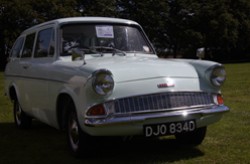
The Anglia was Ford's small car in the 1960s. It was introduced in 1959 as the Anglia 105E. Anglia buyers had a choice of of 1000cc or 1200cc engines. The car had some flashy 50s' styling, including tail fins and a reverse rake rear window. There was plenty of chrome inside and out.
The Anglia was beginning to look a bit dated by the end of the 1960s. Ford replaced it with the best-selling Escort in 1968.
The Escort was a conventionally engineered but well-designed car. The new body was neat and understated. It featured the famous 'dog-bone' grill. The Escort could be all things to all men. It was a basic family car. There were De Luxe and Super versions with better trim. There was also a sporty 1300GT and an Escort Twin-Cam with the Lotus Cortina engine and a top speed of 113mph.
6. Hillman Hunter
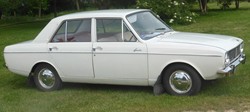
Rootes Group announced the Hillman Hunter in August 1966. It replaced the Hillman Super Minx. The Super Minx was a larger and better equipped version of the company's best-selling Hillman Minx.
The Hunter had an entirely new body, code named 'Arrow'. The curves and 1950s' styling of the old cars disappeared. The Hunter's style was simple and minimalist. It was powered by a 1725cc engine with an aluminium head.
The new Arrow body was introduced across all of Rootes's range of medium-sized cars. It replaced the Hillman Minx, Singer Gazelle, Singer Vogue and Humber Sceptre. There was a fastback version which replaced the old Sunbeam Rapier.
The cars were trimmed to different levels, from the basic Hillman Minx up to the luxurious Humber Sceptre.
The new style cars were in tune with the the market and sold well for Rootes.
Performance and fuel economy were better and the cars were more refined. The original Minx and Super Minx were thought of as comfortable, but slow. The new cars changed Rootes's image.
7. Vauxhall Victor
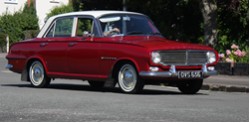
The Vauxhall Victor was a medium-sized saloon car.
Vauxhall introduced the Victor in 1957. The original body was a cut down version of a contemporary Chevrolet saloon from 1956. It was not ideally suited to the British market. The design, although stylish, was not well thought out. Water traps and poor sealing saw Vauxhall get an unwanted reputation for rusty cars.
A new Victor, the FB, launched in 1962 changed that image. The new car was simple and elegantly styled. It had full width radiator grill and a sloping rear tail. The new Victor was carefully rust proofed and lasted well.
The range was topped by a high performance VX4/90 saloon which had a much modified engine with a cast alloy cylinder head.
Vauxhall's policy in the 1960s was one of constant improvement of the Victor range. Vauxhall announced new models in 1964, the FC or Victor 101 and in 1967 the FD Victor.
As Ford did with the Cortina, Vauxhall steadily moved the Victor upmarket. It became larger and more powerful. The FD range was topped by a 2000cc engined car. The Victor was moving away from the basic family saloon class and becoming an executive car. This transformation continued in the 1970s.
8. Hillman Imp
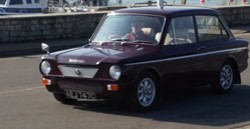
Launched in 1963, the Hillman Imp was Rootes's answer to the Mini. It was an unconventional car with a quirky body style and a cast alloy rear engine.
The new car was light and roomy for its size. Although it never had the character of the Mini.
The Imp was available as basic, De Luxe or Super. There was also a glamorous Imp Californian with a low line roof.
More style and luxury was on offer from Rootes's other badges. There was a Singer version of the Imp called the Singer Chamois and a sporty Sunbeam Stiletto.
9. BMC Farina
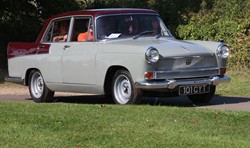
In 1959 BMC introduced a new medium-sized saloon car body to replace the distinctive cars of their Austin, Morris, Wolseley Riley and MG marques.
The body was designed by Pininfarina of Italy. It looked similar to the Peugeot 404, which was also designed by Farina. The engine and running gear was classic BMC.
Each model had different characteristics to suit their loyal customers. The Austin and Morris cars were no-frills family saloons. The Wolseley brought a touch of luxury with walnut facia and door cappings, but was mechanically identical. The Riley and MG cars were tuned for perfomance and also luxuriously trimmed.
The whole range got a facelift in 1961. All cars had a wider tracks, a longer wheel base and an upgraded 1622cc engine. The cars handled and performed better.
These cars continued to sell well for most of the decade, but sales were drying up by the late 1960s.
BMC had intended to replace this range with a new big brother for the Austin/Morris 1100. The original 1500cc concept was somehow upgraded to take the 1800cc B-series from the MGB. It became the Austin/Morris 1800. Unfortunately this was not the car the market wanted and sales were disappointing. This mistake weakened BMC financially. The urgent need for a replacement was eventually met by the rushed development of the Morris Marina.
10. Ford Corsair
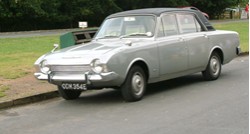
The 1960s' car market in the UK was finely graduated. Some people wanted a basic family car. Others wanted something a bit better, but did not want a large car with a thirsty engine.
This need was partly catered for by standard, De Luxe and Super models. But 1960s' car makers did not offer the range of trim types we get today. The need for something a bit more special was often met by a different car and a different badge. Such as a Wolseley instead of a Morris or a Singer instead of a Hillman. The cars were similar, but differed only in trim and importantly in image.
Ford was not able to do this as they only sold Fords (in the UK at least). So Ford offered a different model. Instead of a Cortina, you could have a Corsair.
The Corsair had a different style, with a Ford Thunderbird inspired front grill. It was better finished and offered better engine options. All for a bit more money.
This was a neat trick for Ford as the Corsair used many of the same parts as the Cortina. It was seen as a different model with different buyers.
The Corsair sold well for most of the 1960s. The range was topped by the Corsair 2000E which offered a luxury interior, a black vinyl roof and a 2000cc engine.
The ranking are derived from sales figures provided by raycee1234.blogspot.com.


Comments
Thanks for that, Had a 1970 Ford Cortina 1600E which was a beautiful car. It went on to be a Concourse champion in the UK. Thanks for the memories.